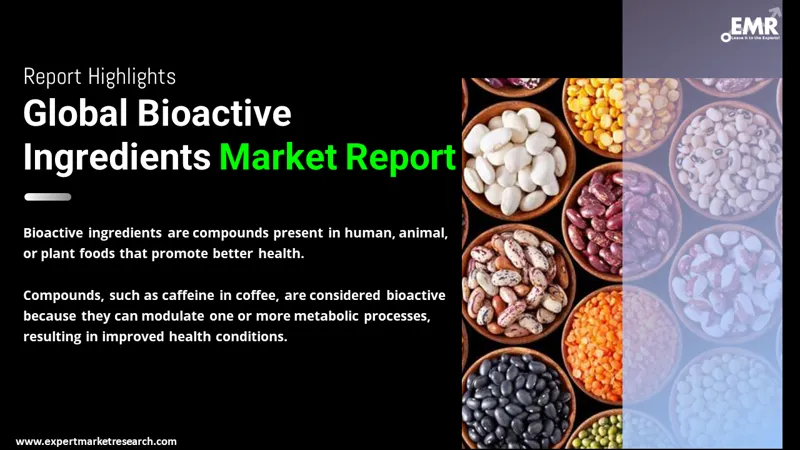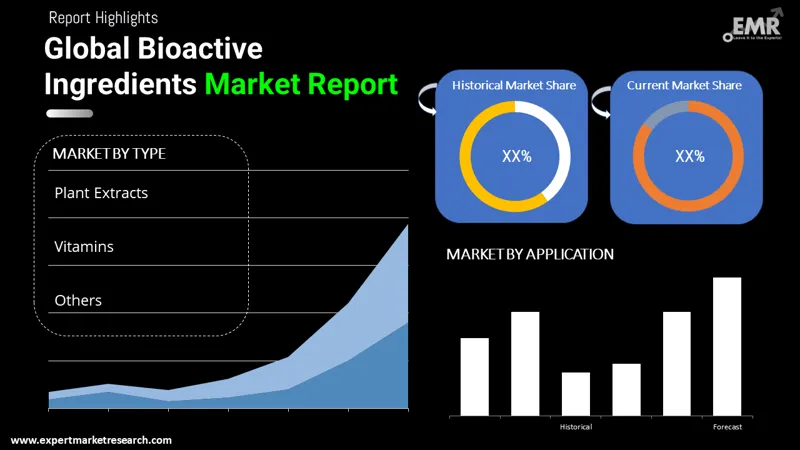
Consumer Insights
Uncover trends and behaviors shaping consumer choices today
Procurement Insights
Optimize your sourcing strategy with key market data
Industry Stats
Stay ahead with the latest trends and market analysis.
The global Bioactive Ingredients Market attained a value of USD 45.88 Billion in 2025. The market is further expected to grow in the forecast period of 2026-2035 at a CAGR of 7.00%, to reach USD 90.25 Billion by 2035.
Base Year
Historical Period
Forecast Period
Compound Annual Growth Rate
7%
Value in USD Billion
2026-2035
*this image is indicative*

Read more about this report - REQUEST FREE SAMPLE COPY IN PDF
The global market for bioactive ingredients is being driven by the rising health awareness among consumers coupled with the growing consumption of bioactive ingredients for various applications. The fibres segment, among other ingredients types, accounted for one of the largest shares in the industry owing to the various health benefits offered by the product. Further, the dietary supplements segment, among other applications of bioactive ingredients, accounts for one of the largest shares in the global industry, along with functional beverages. The increased preference for dietary supplements among consumers with rising health awareness is leading to the growth of this segment, thus, aiding the overall industry growth.
Region-wise, the Asia Pacific is expected to account for a significant share in the global market owing to the presence of a large population, and increased consumption of bioactive ingredients for various applications in the region. Within the Asia Pacific, in countries like China and India, various food fortification programmes are taking place supported by government organisations in order to promote consumers’ health in the region, which is driving the industry growth.
Bioactive ingredients refer to bioactive compounds that are present in foods of humans, animals, or plants, which promote better health. For instance, caffeine can be considered a bioactive compound of coffee. These compounds can modulate one or more metabolic processes, thus, resulting in enhanced health conditions.
The various types of bioactive ingredients are
On the basis of application, the industry can be divided into
Based on region, the market can be divided into

Read more about this report - REQUEST FREE SAMPLE COPY IN PDF
The global market for bioactive ingredients is being driven by its growing consumption in the food and beverage sector owing to the rising awareness regarding health among consumers. With a considerable shift in lifestyle and dietary habits of people, the demand for products with great taste as well as high nutrient content has increased. The gradual shift towards functional foods and beverages, which provide optimal nutrition and are promoted as beneficial basic nutrition, is driving the demand for bioactive ingredients globally.
The growing incidences of lifestyle diseases coupled with the increased expenditure by the ageing population on dietary supplements is providing further impetus to the bioactive ingredients industry. As various diseases and disorders can be prevented with the proper intake of dietary supplements that include vitamins and minerals, its demand is increasing, especially among the geriatric population. Further, manufacturers are increasingly focusing on the development of specialised supplements for age-related disorders and supplements for heart and bones, aiming to target this consumer segment. Thus, the increased demand for enriched and fortified dietary supplements is expected to fuel the growth of the bioactive ingredients industry over the forecast period.
The key players in the industry are investing heavily in the research and development of bioactive ingredients-based products. Thus, new product innovations, coupled with aggressive campaigning and unique brand positioning strategies, are expected to provide a further boost to the industry growth.
Moreover, governments across the nations are taking several initiatives to promote healthy eating habits among people and encourage the intake of healthy ingredients. In developing nations, such as China and India, various schemes and programmes are introduced in order to increase the consumption of fortified food and beverages among the consumers in the region. The rising awareness regarding the fortified food and beverage with ingredients that offer several health benefits without many alternations in the taste will drive the demand for the product in the region. Thus, this will help the global bioactive ingredients industry record a significant growth over the forecast period.
The report gives a detailed analysis of the following key players in the global bioactive ingredients market, covering their competitive landscape, capacity, and latest developments like mergers, acquisitions, and investments, expansions of capacity, and plant turnarounds:
The comprehensive EMR report provides an in-depth assessment of the market based on the Porter's five forces model along with giving a SWOT analysis.




*While we strive to always give you current and accurate information, the numbers depicted on the website are indicative and may differ from the actual numbers in the main report. At Expert Market Research, we aim to bring you the latest insights and trends in the market. Using our analyses and forecasts, stakeholders can understand the market dynamics, navigate challenges, and capitalize on opportunities to make data-driven strategic decisions.*
Get in touch with us for a customized solution tailored to your unique requirements and save upto 35%!
In 2025, the global bioactive ingredients market attained a value of nearly USD 45.88 Billion.
The market is projected to grow at a CAGR of 7.00% between 2026 and 2035.
The major drivers of the market include the shift in lifestyle and dietary habits, gradual shift towards functional foods and beverages, growing incidences of lifestyle diseases, increased expenditure by the ageing population on dietary supplements, heavy investment in the research and development of bioactive ingredients-based products, new product innovations, unique brand positioning strategies, and government initiatives.
The growing consumption in the food and beverage sector and the rising awareness regarding health among consumers are the key industry trends propelling the market's growth.
The major regions in the industry are North America, Latin America, the Middle East and Africa, Europe, and the Asia Pacific with Asia Pacific accounting for the largest share in the market.
The various types of bioactive ingredients are amino acids, carotenoids and antioxidants, fibres and speciality carbohydrates, minerals, omega 3 PUFA, probiotics, peptides and proteins, plant extracts, and vitamins, among others.
By application, the market is divided into dietary supplements, functional food and beverages, personal care, animal nutrition, and pharmaceuticals, among others.
The major players in the industry are Cargill Inc., BASF SE, DuPont de Nemours, Inc., Archer Daniels Midland Company, Owen Biosciences, Inc., and Lonza Group Ltd, among others.
Explore our key highlights of the report and gain a concise overview of key findings, trends, and actionable insights that will empower your strategic decisions.
| REPORT FEATURES | DETAILS |
| Base Year | 2025 |
| Historical Period | 2019-2025 |
| Forecast Period | 2026-2035 |
| Scope of the Report |
Historical and Forecast Trends, Industry Drivers and Constraints, Historical and Forecast Market Analysis by Segment:
|
| Breakup by Type |
|
| Breakup by Application |
|
| Breakup by Region |
|
| Market Dynamics |
|
| Competitive Landscape |
|
| Companies Covered |
|
| Report Price and Purchase Option | Explore our purchase options that are best suited to your resources and industry needs. |
| Delivery Format | Delivered as an attached PDF and Excel through email, with an option of receiving an editable PPT, according to the purchase option. |
Datasheet
One User
USD 2,499
USD 2,249
tax inclusive*
Single User License
One User
USD 3,999
USD 3,599
tax inclusive*
Five User License
Five User
USD 4,999
USD 4,249
tax inclusive*
Corporate License
Unlimited Users
USD 5,999
USD 5,099
tax inclusive*
*Please note that the prices mentioned below are starting prices for each bundle type. Kindly contact our team for further details.*
Flash Bundle
Small Business Bundle
Growth Bundle
Enterprise Bundle
*Please note that the prices mentioned below are starting prices for each bundle type. Kindly contact our team for further details.*
Flash Bundle
Number of Reports: 3
20%
tax inclusive*
Small Business Bundle
Number of Reports: 5
25%
tax inclusive*
Growth Bundle
Number of Reports: 8
30%
tax inclusive*
Enterprise Bundle
Number of Reports: 10
35%
tax inclusive*
How To Order

Select License Type
Choose the right license for your needs and access rights.

Click on ‘Buy Now’
Add the report to your cart with one click and proceed to register.

Select Mode of Payment
Choose a payment option for a secure checkout. You will be redirected accordingly.
Gain insights to stay ahead and seize opportunities.

Get insights & trends for a competitive edge.

Track prices with detailed trend reports.

Analyse trade data for supply chain insights.

Leverage cost reports for smart savings

Enhance supply chain with partnerships.

Connect For More Information
Our expert team of analysts will offer full support and resolve any queries regarding the report, before and after the purchase.
Our expert team of analysts will offer full support and resolve any queries regarding the report, before and after the purchase.
We employ meticulous research methods, blending advanced analytics and expert insights to deliver accurate, actionable industry intelligence, staying ahead of competitors.
Our skilled analysts offer unparalleled competitive advantage with detailed insights on current and emerging markets, ensuring your strategic edge.
We offer an in-depth yet simplified presentation of industry insights and analysis to meet your specific requirements effectively.
Share